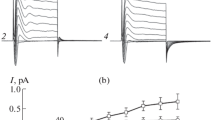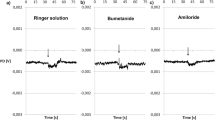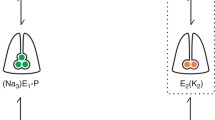Abstract
The voltage-dependence of the inhibitory effect of mucosal Cs+ on the inward K+ current through the apical membrane of frog skin (Rana temporaria) was studied by recording transepithelial current-voltage relations. Experiments were performed with skins exposed to NaCl and KCl Ringer solutions on the serosal and mucosal side respectively (contron skins), as well as with tissues incubated with K2SO4 Ringer solutions on both sides (depolarized skins). Studies of the dose-depedence of the Cs+ block showed that under both experimental conditions the apparent affinity of Cs+ increased as the transepithelial potential was clamped at higher mucosal positive voltages. Under control conditions, the concentration of Cs+ required to block 50% of the K+ current (KCs) recorded while the transepithelial voltage was clamped at zero mV was 16 mmol/1. KCs decreased exponentially with muscosal positive voltages. The dependence of KCs on the membrane potential was analyzed with Eyring rate theory in which Cs+ was assumed to block the K+ transport by binding to a site within the channel. The analysis showed that this site is located at a relative electrical distance δ=0.32 of the voltage drop across the apical membrane, measured from the cytosolic side. The Hill coefficient obtained from this analysis wasn=3.1. Experiments with K+-depolarized tissues showed that only inward K+ currents recorded with positive transepithelial voltages were depressed by external Cs+. Also under these conditions KCs showed an exponential dependence on the transepithelial potential. The analysis of these data with the rate theory revealed δ=0.09 andn=1.7. The difference in δ found in control and depolarized tissues can be explained by the influence of the basolateral membrane resistance on theI–V relations.
Similar content being viewed by others
References
Adelman WJ, French RJ (1978) Blocking of the squid axon potassium channel by external caesium ions J Physiol 276:13–25
Bezanilla F, Armstrong CM (1972) Negative conductance caused by entry of sodium and cesium ions into the potassium channels of squid axons. J Gen Physiol 60:588–608
Cecchi X, Wolff D, Alvarez O, Latorre R (1987) Mechanisms of Cs+ blockde in a Ca2+-activated K+ channel from smooth muscle. Biophys J 52:707–716
Clay JR (1985) Comparison of the effects of internal TEA+ and Cs+ on potassium current in squid giant axons. Biophys J 34:885–892
De Wolf I, Van Driessche W (1986) Voltage-dependent Ba2+ block of K+ channels in apical membrane of frog skin. Am J Physiol 251:C696-C706
Eaton DC, Brodwick MS (1980) Effects of barium on the potassium conductance of squid axon. J Gen Physiol 75:727–750
French RJ, Shoukimas JJ (1985) An ion's view of the potassium channel. The structure of the permeation pathway as sensed by a variety of blocking ions. J Gen Physiol 85:669–698
Gay LA, Stanfield PR 91977) Cs+ causes a voltage-dependent block of inward K currents in resting skeletal muscle fibres. Nature 267:169–170
Hagiwara S, Miyazaki S, Moody W, Patlak J (1978) Blocking effects of barium and hydrogen ions on the potassium current during anomalous rectification in the starfish egg. J Physiol (Lond) 279:167–185
Hagiwara S, Miyazaki S, Rosenthal NP (1976) Potassium current and the effect of cesium on this current during anomalous rectification of the egg cell membrane of a starfish. J Gen Physiol 67:621–638
Hille B (1975) Ionic selectivity, saturation, and block in sodium channels. A four-barrier model. J Gen Physiol 66:535–560
Nagel W, Hirschmann W (1980) K+-permeability of the outer border of the frog skin (R. temporaria). J Membr Biol 52:107–113
Ohmori H (1980) Dual effects of K ions upon the inactivation of the anomalous rectifier of the tunicate egg cell membrane. J Membr Biol 53:143–156
O'Neil RG (1983) Voltage-dependent interaction of barium and cesium with the potassium conductance of the cortical collecting duct apical cell membrane. J Membr Biol 74:165–173
Schwarz W, Neumcke B, Palade PT (1981) K-current fluctuations in inward-rectifying channels of frog skeletal muscle. J Membr Biol 63:85–92
Senyk O (1986) External [K+] and the block of the K+ inward rectifier by external Cs+ in frog skeletal muscle. Biophys J 50:677–683
Standen NB, Stanfield PR (1978) A potential- and time-dependent blockade of inward rectification in frog skeletal muscle fibres by barium and strontium ions. J Physiol (Lond) 280:169–191
Tang J, Abramcheck FJ, Van Driessche W, Helman SI (1985) Electrophysiology and noise analysis of K+-depolarized epithelia of frog skin. Am J Physiol 249:C421-C429
Van Driessche W (1984) Physiological role of apical potassium ion channels in frog skin. J Physiol (Lond) 356:79–95
Van Driessche W, Gullentops K (1982) Conductance fluctuation analysis in epithelia. In: Baker PF (ed) Techniques in the life sciences, techniques in cellular physiology, part II, vol p1/II. Elsevier, North-Holland, New York, pp 1–13
Van Driessche W, Lindemann B (1978) Low-noise amplification of voltage and current fluctuations arising in epithelia. Rev Sci Instrum 49:52–57
Van Driessche W, Zeiske W (1980a) Spontaneous fluctuations of potassium channels in the apical membrane of frog skin. J Physiol 299:101–116
Van Driesshe W, Zeiske W (1980b) Ba2+-induced conductance fluctuations of spontaneously fluctuating K+ channels in the apical membrane of frog skin (Rana temporaria). J Membr Biol 56:31–42
Van Driessche W, Zeiske W (1985) Apical K+ channels in frog skin: a pathway for K+ excretion. In: Gilles R, Gilles-Baillien H (eds) Transport processes, iono- and osmoregulation. Springer, Berlin Heidelberg New York, pp 40–55
Woodhull AM (1973) Ion blockage of sodium channels in nerve. J Gen Physiol 61:687–708
Zeiske W, Van Driessche W (1979) Saturable K+ pathway across the outer border of frog skin (Rana temporaria): kinetics and inhibition by Cs+ and other cations. J Membr Biol 47:77–96
Zeiske W, Van Driessche W (1983) The interaction of “K+-like” cations with the apical K+ channel in frog skin. J Membr Biol 76:57–72
Author information
Authors and Affiliations
Rights and permissions
About this article
Cite this article
De Wolf, I., Van Driessche, W. Current-voltage relations of Cs+-inhibited K+ currents through the apical membrane of frog skin. Pflugers Arch. 413, 111–117 (1988). https://doi.org/10.1007/BF00582520
Received:
Revised:
Accepted:
Issue Date:
DOI: https://doi.org/10.1007/BF00582520




